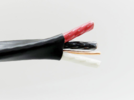Going to change out my 8 gauge wire for 6 gauge and change breaker from 40amp to 50 amp.
Outlet is 19 inches (yes - less than 2 feet) from the Electric Panel.
Should I use single wire or bundle jackets romex wire? If single wire, do I need to use conduit for that short of distance?
already have my 14-50 plug.
cheers
Outlet is 19 inches (yes - less than 2 feet) from the Electric Panel.
Should I use single wire or bundle jackets romex wire? If single wire, do I need to use conduit for that short of distance?
already have my 14-50 plug.
cheers



